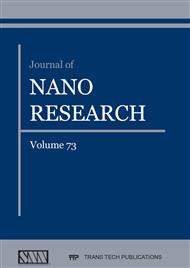[1]
P. Naska, A. Maiti, P. Chakraborty, D. Kundu, B. Biswas & A. Banerjee, Chemical supercapacitors: a review focusing on metallic compounds and conducting polymers. Journal of Materials Chemistry. 9(2021) 1970-2017.
DOI: 10.1039/d0ta09655e
Google Scholar
[2]
Y. Ma, X. Xie, W. Yang, Z. Yu, X. Sun, Y. Zhang, X. Yang, H. Kimura, C. Hou, Z.Guo & Du. W, Recent advances in transition metal oxides with different dimensions as electrodes for high-performance supercapacitors. Advanced Composites and Hybrid Materials. (2021) 1-19.
DOI: 10.1007/s42114-021-00358-2
Google Scholar
[3]
I.M. Budzulyak, O.M. Khemii, O.V. Morushko, D.I. Popovych, Yu. Starchuk, L.S. Yablon, Electrochemical Properties of β-Hydroxide Nickel/Carbon. Nanosistemi, Nanomateriali, Nanotehnologii. 17 (2019) 689–700.
DOI: 10.15407/nnn.17.04.689
Google Scholar
[4]
R. Bharati, R.A. Singh, B.M. Wanklyn, Electrical conductivity, thermoelectric power and dielectric constant of NiWO4. J. Mater. Sci. 15(1980) 1293−1296.
DOI: 10.1007/bf00551819
Google Scholar
[5]
X. Zhang, Z. Li, Z. Yu, L. Wei & X. Guo, Mesoporous NiMoO4 microspheres decorated by Ag quantum dots as cathode material for asymmetric supercapacitors: enhanced interfacial conductivity and capacitive storage. Applied Surface Science. 505(2020) 144513.
DOI: 10.1016/j.apsusc.2019.144513
Google Scholar
[6]
S.M. El-Sheikh & M.M. Rashad, Novel synthesis of cobalt nickel tungstate nanopowders and its photocatalytic application. Journal of Cluster Science. 26(2015) 743-757.
DOI: 10.1007/s10876-014-0735-z
Google Scholar
[7]
P.S. Pandey, N.S. Bhave, R.B. Kharat, Structural, optical, electrical and photovoltaic electrochemical characterization of NiWO4 thin films. Electrochim Acta. 51 (2006) 4659–4664.
DOI: 10.1016/j.electacta.2005.12.042
Google Scholar
[8]
R.D. Kumar, Y. Andou, S. Karuppuchamy, Synthesis and characterization of nanostructured Ni-WO3 and NiWO4 for supercapacitor applications. J. Alloys. Compd. 654 (2016) 349–356.
DOI: 10.1016/j.jallcom.2015.09.106
Google Scholar
[9]
Y. Huang, Y. Gao, C. Liu, Z. Cao, Y. Wang, Z. Li, & G. Cao, Amorphous NiWO4 nanospheres with high-conductivity and-capacitive performance for supercapacitors. The Journal of Physical Chemistry C. 123(2019) 30067-30076.
DOI: 10.1021/acs.jpcc.9b08448
Google Scholar
[10]
L. Niu, Z. Li, Y. Xu, J. Sun, W. Hong, X. Liu, J. Wang & S. Yang, Simple synthesis of amorphous NiWO4 nanostructure and its application as a novel cathode material for asymmetric supercapacitors. ACS applied materials & interfaces. 5(2013) 8044-8052.
DOI: 10.1021/am402127u
Google Scholar
[11]
B.I. Rachiy, B.K. Ostafiychuk, I.M. Budzulyak, R.P. Lisovsky, V.I. Mandzyuk, The effect of thermochemical treatment of carbon materials on their electrochemical properties. Journal of Nano- and Electronic Physics. 6 (2014) 04031.
DOI: 10.1515/nano.11671_2015.115
Google Scholar
[12]
B.K. Ostafiychuk, R.P. Lisovskiy, A.-S.A.H. Zamil, R.I. Merena, A.B. Hrubiak, Effect of orthophosphoric acid on morphology of nanoporous carbon materials. Journal of Nano- and Electronic Physics. 11 (2019) 03036.
Google Scholar
[13]
H. Farsi, S.A Hosseini, The electrochemical behaviors of methylene blue on the surface of nanostructured NiWO4 prepared by coprecipitation method. J Solid State Electrochem. 17(2013) 2079–(2086).
DOI: 10.1007/s10008-013-2068-5
Google Scholar
[14]
M. Malinauskas, A. Žukauskas, S. Hasegawa, Y. Hayasaki, V. Mizeikis, R. Buividas & S. Juodkazis, Ultrafast laser processing of materials: from science to industry. Light: Science & Applications. 5 (2006) e16133-e16133.
DOI: 10.1038/lsa.2016.133
Google Scholar
[15]
L.S. Yablon, О.M. Khemiy, І.М. Budzulyak, B.K. Ostafiychuk, O.V. Morushko, Effect of laser irradiation on Electrochemical Properties of composite MoS2/C. Physics and Chemistry of Solid State. 17(2016) 575-581.
DOI: 10.15330/pcss.17.4.575-581
Google Scholar
[16]
B.I. Rachiy, Yu.Yu. Starchuk, P.I. Kolkovskyy, I.M. Budzulyak, L.S. Yablon, V.O. Kotsyubynsky, O.V. Morushko, O.M. Khemiy, Accumulation of Charge Mechanisms in Electrochemical Systems Based on Carbon and Nickel Tungstate. Surface Engineering and Applied Electrochemistry. 56 (2020) 697-703.
DOI: 10.3103/s1068375520060149
Google Scholar
[17]
P. Sharma, M. Minakshi, J. Whale, A. Jean-Fulcrand, & G. Garnweitner, Effect of the anionic counterpart: Molybdate vs. tungstate in energy storage for pseudo-capacitor applications. Nanomaterials. 11 (2021) 580.
DOI: 10.3390/nano11030580
Google Scholar
[18]
M. Li, S. Xu, Y. Zhu, P. Yang, L. Wang & P.K. Chu, Heterostructured Ni (OH) 2–Co (OH) 2 composites on 3D ordered Ni–Co nanoparticles fabricated on microchannel plates for advanced miniature supercapacitor. Journal of alloys and compounds. 589 (2014) 364-371.
DOI: 10.1016/j.jallcom.2013.11.230
Google Scholar


